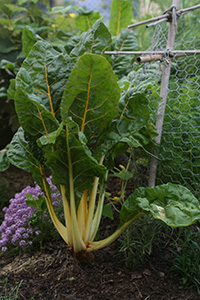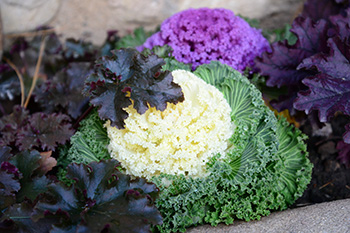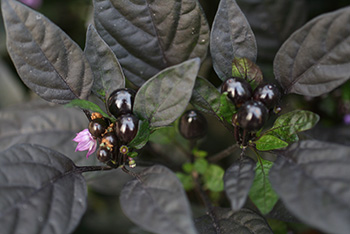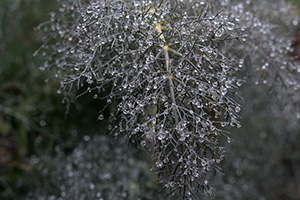Ornamental Vegetables

As foodscaping grows in popularity, ornamental vegetables are increasingly being added to landscapes since they’re both beautiful and delicious. Vibrant foliage, unique fruits, and new textures make the typical vegetables we grow a little more exciting.
Swiss Chard
Swiss chard doubles as an easy-to-grow vegetable and an attractive ornamental that comes in an array of colors. There are plenty of varieties to try, but one of our favorites is ‘Bright Lights’ that presents stalks in fuchsia, crimson, gold, and cream. Pair ornamental Swiss chard with flowers in your landscape to really accentuate the colorful stalks.
Lettuce
Lettuce brings both texture and color to the landscape. Their short, rounded forms with curly leaves are ideal for placing at the front of a planting. Choose ‘Freckles’ romaine lettuce for green leaves that are dotted with purple. Add in some color with ‘Red Sails’ or one of the red Salad Bowl varieties, and you have an attractive edible arrangement.
Kale

There are two varieties of kale to choose from: edible or ornamental. Although not as showy as the ornamentals, there are still several types of edible kale that can elevate the landscape. Dinosaur kale has long, linear leaves that are dusty-blue and crinkly in texture. ‘Redbor’ has the typical kale appearance, except the entire plant is a striking plum color.
If you want maximum drama, then choose an ornamental variety such as ‘Pigeon Purple’ or ‘Glamour Red’. These varieties are often called “flowering kale” since the plant looks like a large, dramatic bloom. Although technically edible, ornamental kale is best used as a garnish since it tends to be bitter.
Mustard
Mustard is already visually appealing, with its broad, deeply veined leaves. For extra drama, plant an ornamental variety like ‘Giant Red.” The wine-colored leaves contrast nicely with their lime-green midribs. For maximum visual impact, place ornamental mustard next to plants with lighter foliage or pale flowers.
Cabbage
Cabbage doesn’t have to be the typical green; it also comes in shades of red and purple. ‘Savoy Red Acre’ produces a particularly interesting head of cabbage that is deep purple with a frosty sheen. Use it to break up the green in sunny parts of your landscape.

Romanesco cauliflower
Cauliflower
Ornamental vegetables are not limited to only foliage! There are also ornamental varieties of cauliflower that produce heads of varying colors and textures that look nothing like the grocery store varieties. Romanesco is one such variety, which produces a green, spiny-looking head. Other varieties produce a typical-looking curd that is orange, green, or purple instead of white.
Peppers, Tomatoes & Eggplants
As with kale, peppers are categorized as edible or ornamental. The usual pepper varieties are still visually appealing, with fruits that come in all colors of the rainbow. However, ornamental peppers take aesthetics to the next level. ‘Black Pearl’ sports both inky leaves and fruits; ‘Calico’ dazzles with mottled purple, cream, and green leaves; ‘Purple Flash’ glows violet; and ‘Sangria’ bursts with tiny red and purple peppers against green foliage. Eating these peppers is not recommended since they tend to be far spicier than their edible counterparts.

Ornamental peppers
Heirloom tomatoes are also available in many hues, patterns, and sizes. ‘Cherokee Purple’ has an ombre effect of purple to red, ‘Green Zebra’ is pale green with stripes of lime, and ‘Mortgage Lifter’ is a super-sized red tomato that is sure to shock your visitors. Choose unique trellises to support your tomato plants for further appeal.
There are also plenty of nontraditional eggplants to choose from. ‘Long’ and ‘Ichiban’ produce narrow, stretched fruits, while ‘Cloud Nine’ has a striking fruit that looks just like an egg. Treat your peppers, tomatoes, and eggplants as you would flowers--place them wherever your landscape needs color.
Beans
There are many showstopping bean varieties, including some with delightful flowers. Hyacinth bean has hot-pink flowers and deeply purple bean pods. As the name suggests, winged beans have unique pods with four ruffled “wings” running lengthwise down the pods. Last, but not least, scarlet runner beans have brilliant orange flowers and unassuming green pods that split open to reveal hot pink and purple beans. Regardless of “dazzle” level, all beans need to climb, so use trellises or plant them along a fence.
Herbs

Bronze fennel
Did you know that many herbs come in alternate colors? Bronze fennel is one such herb. This variety of fennel produces a cloud of feathery foliage in shades of grey, russet, and plum. Another option is basil; some varieties are such a deep shade of purple that they appear almost black. We recommend adding ‘Purple Ruffle’ or ‘Osmin’ to your garden to bring shades of violet into your landscape and your dishes. The sunny yellow flowers of Mexican tarragon would look particularly striking against the backdrop of bronze fennel and purple basil.
Keep your ornamental vegetables watered and fertilized well, and in a sunny location. Most of these plants should go in the ground during the cool season, but in warmer months, you can plant things like peppers, tomatoes, beans, and colorful basils.
For help with choosing the best ornamental vegetables for your landscape, contact the experts at your county Extension office.
Also on Gardening Solutions
- Add a Thrilling Porch Planter for Fall
- Basil
- Cabbage
- Cardoon
- Foodscaping
- Kale
- Ornamental Gourds
- Ornamental Peppers
- Peppers
- Swiss Chard

